Road agencies in the US are turning to geo-synthetic bridge enforcement technology to lower costs, slash construction time, improve durability and increase safety.

The US Federal Highway Administration (FHWA) has been promoting the Geo-synthetic Reinforced Soil (GRS) Integrated Bridge System (IBS) since 2010 through its Every Day Counts initiative, which aims to identify and rapidly deploy proven but under-utilised innovations with the ability to shorten the project delivery process, enhance roadway safety, reduce congestion and improve environmental sustainability. Since then, the number of GRS-IBS structures in the US has risen to almost 300.
Instead of a conventional bridge deck supported on pile-cap or concrete wall abutments, GRS-IBS technology involves alternating layers of compacted granular fill material and fabric sheets of geo-textile reinforcement to provide support for the bridge. Rather than installing a deep foundation, this reinforced soil method builds up the substructure in a faster, simpler way.
Building a GRS mass involves three simple steps. First, builders lay a row of facing blocks. Second, they add a layer of compacted fill to the height of the facing blocks. Next, they add a layer of geo-synthetic fabric. The process is repeated over and over until the desired height is achieved. The construction of the GRS mass should then follow two simple rules. First, thin layers of granular fill materials should be well compacted. Second, the reinforcement should be placed in closely spaced layers.
GRS-IBS also provides a smooth transition from the bridge onto the roadway, and alleviates the bump drivers feel when crossing from the road onto the bridge, caused by uneven settlement between the bridge and approaching roadway.
The FHWA advises that GRS-IBS structures can be completed faster and at lower cost th

an alternatives, owing to the fact that construction involves basic earthwork methods and practice, does not require highly skilled labor, and employs commonly available equipment and materials. Constructing a GRS-IBS bridge can cost 25 to 60% less than one built with conventional methods, depending on the standard of construction and the method of contracting.
Time-wise, a bridge built with this technique can be constructed in less than two weeks, according to the authors of the
report Geo-synthetic Reinforced Soil Integrated Bridge System.
Once built, GRS-IBS bridges are also durable and easy to maintain. This, combined with fewer components compared to traditional construction, also provides the potential for lower life-cycle costs.
The FHWA advises that additional features of GRS-IBS technology are convenience and flexibility. The technique can be used in less-than ideal weather conditions and can accommodate on-site modifications in the case of unforeseen site conditions. GRS-IBS bridges also perform well and can be designed for a wide range of loading conditions, such as in seismic areas and rapidly changing water elevations.
For more information, visit the
FHWA website.
Images: Courtesy of FHWA